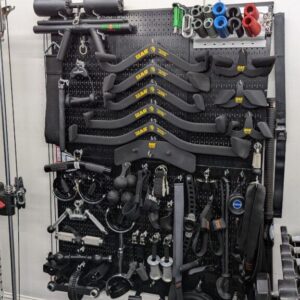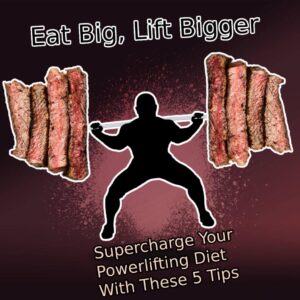Top 3 Reasons You Should Be Doing Single Leg Exercises As A Powerlifter
Gym-goers of all types, but perhaps especially powerlifters, tend to hold a certain disdain for single leg exercises. It’s understandable, as single leg movements do suck. You can’t use as much weight, so they’re not cool. They make you sore. They feel awkward. You got into this because you wanted to lift heavy stuff, not balance side to side with 45lbs. These drawbacks are valid, I’ll agree. However, we can unlock some serious benefits that far outweigh the negatives by using single leg exercises.
Table of Contents
Transparency Note
Some of the items and links in this article might be affiliate links, or might be linked to a Sponsor of the Garage Gym Competition. These links and sponsorships help fund the website, the competition itself, the newsletter, non-profit donations, and everything else we do FOR FREE here at the GGC. I like to be transparent so you know what is up. I appreciate the support if you choose to use the links.

Negatives Of Single Leg Exercises
Let me address the perceived negative aspects of single leg training that we just discussed.
First, the fact that we can use less weight to achieve a stimulus is a benefit, not a detriment. As a powerlifter, we are often loading HEAVY weights in our hands and on our backs, multiple times a week, for multiple reps and sets. This is great for building strength in the only lifts that “matter” in Powerlifting, the Squat, Bench, and Deadlift. But when it comes time for our accessory lifts, you don’t win on the platform because you can Leg Press 1000lbs. If you can achieve similar carryover results by loading less weight, why not?
Any exercise that will lead to strength and hypertrophy gains without applying a hefty tax on our joints and central nervous system should be cherished. These lower weight exercises that are still challenging, allow us to keep the intensity of our accessory work HIGH, while allowing us to keep the heavy load for where it is needed.

Second, single leg exercises can create soreness in areas you didn’t even know you had muscles. Those split squats that your coach programmed may make your buns and thighs so sore during Week 1 of the block that you can barely walk. But guess what, the first time you back squatted you were sore too! Your body will adapt. And that is a good thing. You don’t need a LOT of novel stimulus, but mixing things up, especially in the off-season as a powerlifter, avoids that repeated stress of always using nothing but heavy straight bar work.
Third, they feel weird. Yeah, they do. Ever watch someone try something they haven’t done before? It typically takes a bit for them to get the coordination and technique down. You might feel so awkward at first that you may not even be sure if you’re doing them right. Leave your ego at the door, reduce or remove the weight, brace your core as with any compound lift, and focus on executing the lift properly FIRST, then adding more reps and resistance as you progress.
Benefits Of Single Leg Exercises
The benefits of single leg exercises are bountiful.
First, they offer the opportunity to build the legs with minimal loads, therefore reducing fatigue and wear and tear. I mentioned this above, you are likely already loading heavy weights in your Squat, Bench, and Deadlift. These are similar enough movement patterns to have some carryover, while being brutally difficult at low weights. And the science tells us, that the most important piece to progress is a difficult set, not necessarily the weight used.

Second, they prepare us for sport and life outside of the gym. Strengthening in a unilateral range of motion improves the ability to run, jump, and change direction efficiently. For parents, think about wrestling with your kids, picking them up off the floor, chasing after them at the park. These are all movements that require you to have equal parts mobility, stability, flexibility and strength. Squats and Deadlifts are straight up and down. Single Leg Exercises can be side to side, at angles, forward, back, and more. They open up opportunities the big lifts can’t here.
Finally, they are staples in injury prevention and rehabilitation. If you have one leg stronger than the other, it can be masked by a two-legged exercise like a back squat. But try and do 15 reps with each leg on a Single Leg Exercise and watch as one struggles and the other passes with flying colors. You can identify, diagnose, and correct movement pattern deficiencies with single leg exercises. They correct weak points, improve balance, and force the lifter to recruit core and hip stabilizers. And seriously, no one ever got hurt or missed a lift because their hips and core were TOO STRONG!
How To Do Single Leg Exercises
There are countless ways to execute single leg exercises. There are several squat and hinge variations that can be done one-legged and a seemingly infinite amount of ways to load these movements. I’m going to break them down here by the five human movement patterns: squat, hinge, push, pull, and carry. Some folks give “single leg” its own category, but we aren’t doing that here. Here are my favorite single leg exercises:
Squat Pattern
Lunges
If the squat is the king of exercises, then the lunge is the king of single-leg exercises. They work the anterior and posterior chains as well as one’s ability to stabilize and brace. At the risk of sounding like Bubba Blue from Forrest Gump, you can do them forwards, backwards, stationary, walking, loaded, unloaded, low reps, high reps, you name it. Romain Guerin has his professional rugby athletes do bar-loaded reverse lunges as a main movement. Cory G used to do 800M of forward walking lunges a day for conditioning.
The possibilities are endless. To someone looking to get into single-leg training, I recommend stationary lunges, both forwards and backwards, for sets of 10 per leg. Build your strength, comfort, and efficiency in this range of motion before adding a ton of weight, volume, or variation.
Step-Ups
These are really just a variation of the lunge, where the lifter steps up onto an elevated surface such as a box. They hit a lot more glute than your standard lunge. As a hiker and mountain trail runner, I will do these for higher-rep sets in order to build the muscular endurance I’ll need to propel myself up mountains and hills. I recommend starting the box around knee height and progress no higher than hip height. Dumbbells are my preferred loading method for these.
Split Squats
We love to hate these. Coaches love to program them, and for good reason. Unlike a lunge, the passive leg is propped up on a bench, bar, or pad, allowing for a deeper range of motion. I like to load these with dumbbells in each hand; this builds grip strength and helps you balance during the exercise. I give split squats a lot of credit in helping me add 50lbs to my squat while training for my most recent powerlifting meet.
Hinge Pattern
Back Extensions
I first heard about the single-leg back extension from Sam Brown’s awesome article. This is a great first single-leg hinge as it does not require the balance and proprioception that a Romanian Deadlift does. Simply place the passive leg behind or on top of your back extension’s pad/plate, brace your core, engage your glute and extend (NOT HYPEREXTEND) the torso as if you are locking out a deadlift. This is a great glute and hamstring builder.
I really think that these played a big part in conquering the lower back pain that plagued me for years before investing in a back extension piece for my garage gym. I do these unweighted for sets of 6-10. If you plan to add weight, keep it very light–these work well enough unweighted.
Romanian Deadlifts
Single leg RDLs are a great builder of balance and stability. I would not push a ton of load or volume with this exercise; in fact, I like to save these for deload weeks when I want to include a challenging movement that won’t beat me up too badly. I would start unweighted, progress to a light dumbbell or kettlebell in each hand, and eventually switch to holding a weight in only one hand in order to further challenge your control.
Ways to Load Single Leg Exercises
- Don’t – most of these are hard enough on their own!
- Hold a plate or medicine ball at your chest/torso
- Dumbbells or kettlebells – this is a great grip builder, especially on long, high-rep sets of lunges or step-ups
- Barbell – for when you’re comfortable and ready to push it; lunges are probably the single leg exercise of choice if you’re looking to move heavier weights
- Safety Squat Bar – to give those shoulders and elbows a break
You can get creative here. Remember those kids? Hold them and do your sets. Grab a band, anchor it to a rack on one side so it PULLS you over and do lunges fighting to stay balanced. Mix in balancing devices, do lunges off blocks, and more.
Some will even argue that exercises like sled work is single leg in nature. So you have a TON of opportunities here.
Wrap Up On Single Leg Exercises

That’s it! We’ve covered the benefits of single leg work, a handful of exercises to try, and a bunch of different ways in which we can load them. All that’s left is for you to get out there and give it a shot–you’ll be glad you did. Check out the articles below for more great information on single leg training.
This article was written by Hunter Richardson. Check out his Bio and other articles here. And find him on Instagram, at his Blog, or his EliteFTS articles for more.
📌Enjoy Powerlifting? Want to enter a FREE competition with thousands of dollars in prizes and donations to non-profits? Check out our next event!
🏅 Own a home gym? Like to save money? Check out my full list of discount codes.
Additional Reading
“4 Hidden Benefits of Single-Leg Training.” Rehab2Perform, 18 Feb. 2021, rehab2perform.com/news/benefits-single-leg-training/#:~:text=Single%2Dleg%20exercises%20promote%20strength,major%20contributors%20to%20alignment%20issues.
Brown, Sam. “The Elitefts Scholastic Back Raise: 8 Exercises You Aren’t Doing.” EliteFTS, 7 July 2019, www.elitefts.com/education/8-exercises-you-arent-doing-with-the-elitefts-back-raise/.
English, Jarred. “The Benefits of Single Leg Training.” Savannah Personal Training, 20 July 2016, www.tidewaterfitness.org/benefits-single-leg-training/.
Guerin, Romain. “Reverse Lunges: The Weapon for Strength Development in Running Sports.” EliteFTS, 6 Apr. 2022, www.elitefts.com/education/reverse-lunges-the-weapon-for-strength-development-in-running-sports/.
Holder, Brandon. “Single-Leg Conjugate Training for Athletes.” EliteFTS, 28 Jan. 2023, www.elitefts.com/education/single-leg-conjugate-training-for-athletes/.



